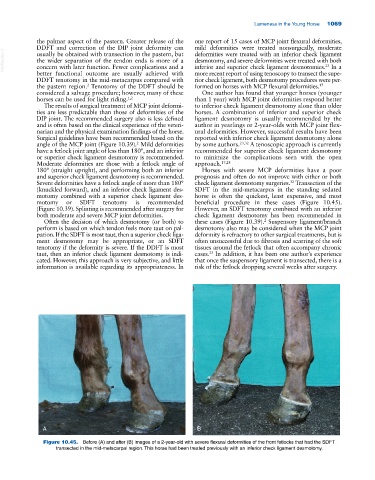Page 1103 - Adams and Stashak's Lameness in Horses, 7th Edition
P. 1103
Lameness in the Young Horse 1069
the palmar aspect of the pastern. Greater release of the one report of 15 cases of MCP joint flexural deformities,
DDFT and correction of the DIP joint deformity can mild deformities were treated nonsurgically, moderate
VetBooks.ir the wider separation of the tendon ends is more of a desmotomy, and severe deformities were treated with both
deformities were treated with an inferior check ligament
usually be obtained with transection in the pastern, but
inferior and superior check ligament desmotomies. In a
concern with later function. Fewer complications and a
23
better functional outcome are usually achieved with more recent report of using tenoscopy to transect the supe
DDFT tenotomy in the mid‐metacarpus compared with rior check ligament, both desmotomy procedures were per
2
the pastern region. Tenotomy of the DDFT should be formed on horses with MCP flexural deformities. 17
considered a salvage procedure; however, many of these One author has found that younger horses (younger
horses can be used for light riding. 1,2 than 1 year) with MCP joint deformities respond better
The results of surgical treatment of MCP joint deformi to inferior check ligament desmotomy alone than older
ties are less predictable than those of deformities of the horses. A combination of inferior and superior check
DIP joint. The recommended surgery also is less defined ligament desmotomy is usually recommended by the
and is often based on the clinical experience of the veteri author in yearlings or 2‐year‐olds with MCP joint flex
narian and the physical examination findings of the horse. ural deformities. However, successful results have been
Surgical guidelines have been recommended based on the reported with inferior check ligament desmotomy alone
angle of the MCP joint (Figure 10.39). Mild deformities by some authors. 23,32 A tenoscopic approach is currently
2
have a fetlock joint angle of less than 180°, and an inferior recommended for superior check ligament desmotomy
or superior check ligament desmotomy is recommended. to minimize the complications seen with the open
Moderate deformities are those with a fetlock angle of approach. 17,28
180° (straight upright), and performing both an inferior Horses with severe MCP deformities have a poor
and superior check ligament desmotomy is recommended. prognosis and often do not improve with either or both
Severe deformities have a fetlock angle of more than 180° check ligament desmotomy surgeries. Transection of the
32
(knuckled forward), and an inferior check ligament des SDFT in the mid‐metacarpus in the standing sedated
motomy combined with a superior check ligament des horse is often the quickest, least expensive, and most
motomy or SDFT tenotomy is recommended beneficial procedure in these cases (Figure 10.45).
(Figure 10.39). Splinting is recommended after surgery for However, an SDFT tenotomy combined with an inferior
both moderate and severe MCP joint deformities. check ligament desmotomy has been recommended in
Often the decision of which desmotomy (or both) to these cases (Figure 10.39). Suspensory ligament/branch
2
perform is based on which tendon feels more taut on pal desmotomy also may be considered when the MCP joint
pation. If the SDFT is most taut, then a superior check liga deformity is refractory to other surgical treatments, but is
ment desmotomy may be appropriate, or an SDFT often unsuccessful due to fibrosis and scarring of the soft
tenotomy if the deformity is severe. If the DDFT is most tissues around the fetlock that often accompany chronic
23
taut, then an inferior check ligament desmotomy is indi cases. In addition, it has been one author’s experience
cated. However, this approach is very subjective, and little that once the suspensory ligament is transected, there is a
information is available regarding its appropriateness. In risk of the fetlock dropping several weeks after surgery.
A B
Figure 10.45. Before (A) and after (B) images of a 2‐year‐old with severe flexural deformities of the front fetlocks that had the SDFT
transected in the mid‐metacarpal region. This horse had been treated previously with an inferior check ligament desmotomy.

